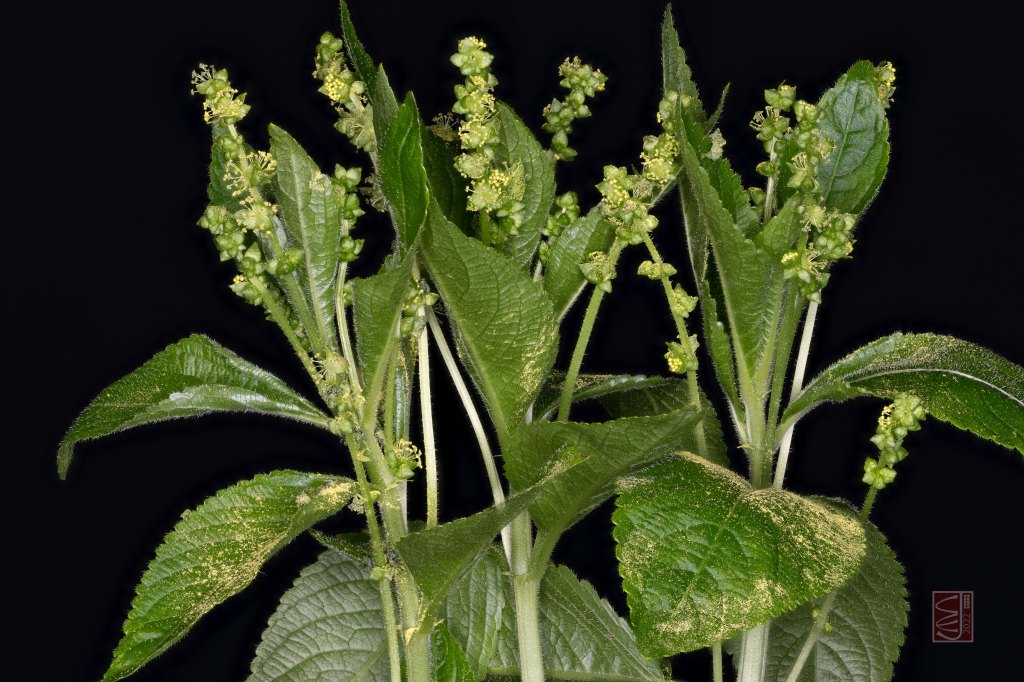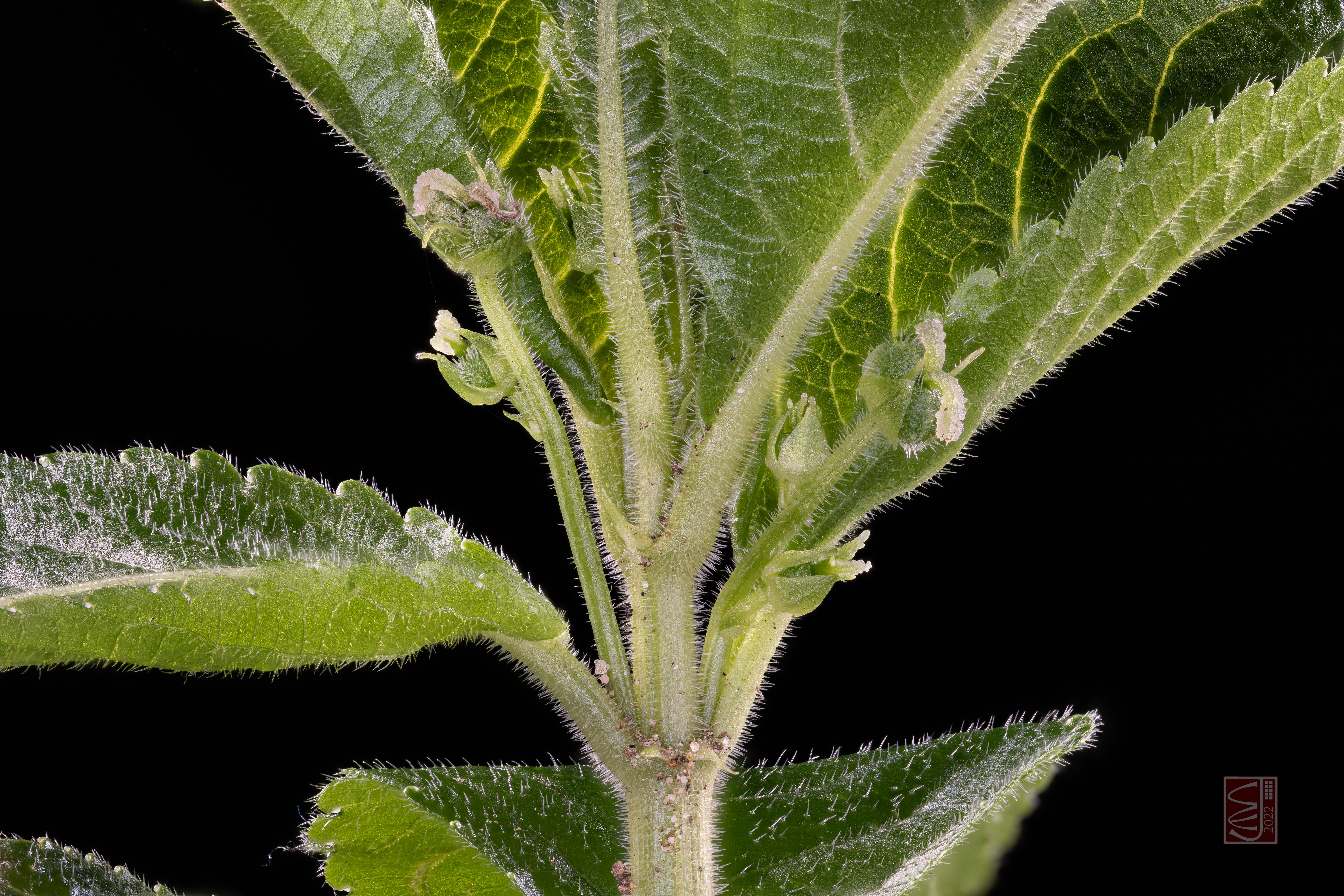
This is another flower of early spring. You may see it in woodlands from February onwards. It often forms a dense green mat over large areas. It is one of the species considered to be more or less ‘faithful’ to ancient woodlands of oak, ash, beech and alder. Arthur Tansley, the ‘father of British ecology’ described how Mercurialis perennis takes advantage of the prevailing light, before the tree canopy closes.

It is a native perennial, with erect stems arising from creeping rhizomes, the shoots reaching a height of no more than 40 cm. Its status as a British native can never be in doubt: its pollen and fruit occur in lake deposits throughout Britain well before the appearance of modern humans. The earliest dates are 400,000 years B.P., implying that Mercurialis perennis survived four glacial periods. The historical records start from 1571; a few years later came an entry in Gerard’s Herbal (https://www.exclassics.com/herbal/herbalv20053.htm#i%20533). He recognised the separate male and female plants but had only a little to say about its use in medicine:
In Salamanca they give and much commend the decoction — against the bitings of a mad dog. The Moors at Granada use them frequently in women’s diseases.

Culpeper’s Complete Herbal (1653) goes much further, with a substantial entry including botanical information alongside many medical recommendations, all of which seem highly dubious by today’s standards. However, Culpeper did know the plant to be poisonous, and most of his ‘cures’ relate to topical applications (poultices, insertions, weak infusions).
In fact, the plant is highly poisonous (see below).
It belongs to the spurge family Euphorbiacea, a huge and variable family known for its most unusual green flowers (sometimes yellow or bluish), milky latex (but only watery in the case of Mercurialis), and poisonous compounds. Each ‘flower’ is a miniature inflorescence made of a single female flower surrounded by several male flowers (only one stamen each) enclosed in a leafy cup-shaped bract. In the Euphorbiacea there are usually no true petals, but ‘tepals’ (when the structure is not obviously a petal or a sepal it’s called a tepal). There is little colour to attract insects, and pollination is often by wind. However, some genera (eg Euphorbia) have scented flowers that attract bees and even lizards. The family has several ‘celebrity’ species, some of great economic importance: the rubber tree (Hevea brasiliensis), the Castor Oil plant (Ricinus communis), Cassava (Manihot esculentus) and many high-value ornamental species including the Poinsettia (Euphorbia pulcherrima).


In Mercurialis the floral arrangement is much different from the Euphorbiaceous norm. There are separate male and female plants with their own flower type. Exploration and interpretation of the flowers is quite a challenge! The high-resolution images from Chris Jeffree show rather more than you may be able to see for yourself with a hand-lens. The usual Euphorbia flower-type is presumably ancestral and has been abandoned in Mercurialis in favour of almost complete sexual dimorphism as the images here show. Seeds are said to be shed from the 2-seeded capsule ‘explosively’; they are dormant until winter chilling: they normally germinate in the following year. Seedlings are often observed but the main reproductive mechanism is vegetative, via the rhizomes.
Given the huge disparity between the reproductive structures of Mercurialis and Euphorbia, I wonder whether Mercurialis should be placed in a different family. I have conducted a search in the journal Taxon, where such issues are often discussed, but I find no hint of change.
The number of chromosomes is usually given as 2n=64 and this may be true for British material but in fact there is much polyploidy within the species as a whole with chromosome numbers varying from 2n=42 to 112. Krahenbühl et al (2002) mention 43 different ‘cytotypes’ each with a different number of chromosomes. In their survey of the ten species in the genus Mercurialis (in Britain we have only two species M. perennis and M. annua) it turns out that most of the chromosome counts are divisible by 8, suggesting evolution of ten species from an ancestral form which had only eight chromosomes. I cannot find any information on the chromosomal basis of sexuality – my guess is that the cytogenetics have not been investigated from this point of view.
The male and female plants differ somewhat. Sexual dimorphism in plants is less common than in animals but is by no means rare. In M. perennis, the male clones have more shoots, longer stolons and more flowers and usually outnumber the females. However, the females invest more in sexual reproduction (forming seeds is hard work).

The species is widespread in Britain and Europe. It is rare in Ireland, but reported several years ago from the Burren in County Clare (and now there are more records). It is not clear whether it is native in Ireland; it may have been introduced either deliberately or accidentally. Beyond Europe it is uncommon – there are just a few strange-looking records on other continents. It evidently does not travel far – seed dispersal is reported to be by ants (myrmecochory).
Although well-known as a species of the woodland floor, it does occur elsewhere on soils that are not too acid (it prefers a neutral soils, often associated with limestone or clay; it is absent from wetlands). Jefferson (2008) mentions hedgerows, shady places among rocks and in open conditions including semi-natural grasslands, tall-herb vegetation, screes and in the grikes of limestone pavements in the Pennines and elsewhere. Its survival in the treeless landscapes of glacial Britain is noteworthy – where did it live? Rocky outcrops, scree? Its tolerance of heavy metals (cadmium, lead and zinc) has been noted by several authors, perhaps an evolutionary legacy of many generations with a close proximity to rocks.
There are many records of poisoning by Dog’s Mercury, both of humans and livestock. In the British Medical Journal Rugman et al. (1983) describe one such case. A school-teacher and his wife had collected what they thought was brooklime (Veronica beccabunga) after reading about it in Richard Mabey’s popular book Food for Free. Alas, it was Dog’s Mercury. Four hours after eating boiled material “both presented to hospital seriously ill and complaining of nausea, vomiting, and severe bilateral colicky loin pains. Both patients
were flushed and sweating and had a curious malar erythema”. They were very ill, but promptly treated and they survived. The authors, two medical doctors and a botanist, conclude their short paper with a warning “Publications which fail to give accurate and detailed colour illustrations of plants should be treated with caution. Moreover, the appearance of a species varies with habitat, and this remains a trap for the unwary”.

The toxic component may be Methylamine (known as mercurialine) a volatile oil with a rather simple chemical formula (ammonia NH3 but with one H replaced by a methyl group CH3).
What about its name, Dog’s Mercury? Culpeper called it Dog Mercury in 1653; neither the element Mercury nor the planet Mercury had been discovered then, and so the name relates to the deity, the Roman god of shopkeepers and merchants. Culpeper makes the cryptic comment “Mercury they say owns the herb, but I rather think it is Venus’s”. I think he says this because the herb was used to treat female complaints. The ‘Dog’ part of the name may derive from the foetid smell – they thought it smelt of dogs. Or it may simply refer to ‘dog’ as a word for abuse or contempt. From early times, Mercurialis was the name given to another completely different species, now Chenopodium bonus-hendricus. As often, there was taxonomic confusion until the 18th Century when Carl Linnaeus named so many plants, including Mercurialis perennis and herbarium specimens began to be kept for reference purposes.
Is the species threatened? It remains common wherever there are ancient woodlands on fertile soils, but in some parts of Scotland I’ve seen it being overwhelmed by an invasive species from Asia, the Few-flowered Garlic, Allium paradoxum. This plant competes very successfully with the native ground flora including the native wild garlic Ramsons, Allium ursinum.
There is a closely-related species, Mercurialis annua, possibly a native. Richard Milne has shared the image below. This one is an annual plant, without the rhizomes and no hairs on the leaves. It isn’t a woodland plant: it grows in fertile open habitats, arable land is the preferred habitat. It isn’t common, but it does occur in Scotland. I am not familiar with this species – I shall be looking out for it.

References
Jefferson RG (2008) Biological Flora of the British Isles: Mercurialis perennis L. Journal of Ecology 96, 386-412. Free Access: https://doi.org/10.1111/j.1365-2745.2007.01348.x
Krahenbühl M, Yuan YM, and Kiipf P (2002) Chromosome and breeding system evolution of the genus Mercurialis (Euphorbiaceae): implications of ITS molecular phylogeny. Plant Systematics and Evolution 234, 155-169
Pfeiffer T et al (2019) A battle of the sexes? Sex ratio and performance at small scales in dioecious Mercurialis perennis. Acta Oecologia 100, 103462.
Rugman F, Meecham J and Edmondson J (1983) Mercurialis perennis (dog’s mercury) poisoning: a case of mistaken identity. British Medical Journal 287,24-31.
©John Grace